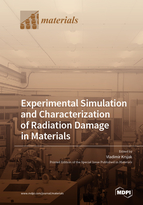Experimental Simulation and Characterization of Radiation Damage in Materials
A special issue of Materials (ISSN 1996-1944). This special issue belongs to the section "Materials Physics".
Deadline for manuscript submissions: closed (20 September 2022) | Viewed by 16009
Special Issue Editor
Interests: nondestructive testing (NDT); radiation effects in solids; irradiation experiments; ion irradiation; helium embrittlement; spallation target materials; positron annihilation spectroscopy; nanostructured alloys
Special Issue Information
Dear Colleagues,
The development of new materials for the next generation of advanced nuclear technology brings about the need for suitable irradiation experiments and reliable/reproducible post-irradiation examination (PIE). The standardized testing of activated materials in hot-cell facilities might still be considered unavoidable for nuclear power reactor development, yet exposure to fission neutron radiation cannot adequately simulate the radiation environments of nuclear fusion or spallation neutron sources. For this reason, considerable effort has been devoted to the use of ion bombardment as a surrogate for neutron irradiation and to develop new, innovative methods for material characterization. The use of particle accelerators to simulate harsh radiation environments provides an easily controlled radiation environment which enables us to isolate and study the effects of temperature, displacement damage rate, or to effectively simulate transmutation reactions in materials. These desirable features of ion implantation experiments are, however, counterbalanced by a non-uniform damage profile, which either requires variable-energy ion implantation or a special depth-sensitive characterization technique. In the latter case, the profile advantageously enables us to probe very different damage regions within the sample, providing a large number of data points from a single irradiation experiment. Numerous recent studies indicate that a considerable step forward in the understanding of material performance in extreme environments can be achieved by a combination of principally different experimental approaches used in the same irradiation study. To improve our knowledge of the comprehensive synergistic effects of individual environmental and material variables, it is necessary to conduct very rigorous and repeatable irradiation experiments evaluated by characterization techniques which provide unique yet reproducible results. At the same time, it is essential to share the latest innovations, developments, and applications effectively and to reach the right professional audience.
This Special Issue of Materials aims at advancing the current knowledge in ion irradiation studies and innovative material characterization. Especially welcome are research papers that address ion beam irradiation of materials for functional and structural nuclear components, innovative materials for nuclear applications, and advanced techniques for the characterization of ion beam modified materials. The journal accepts original research papers as well as review articles summarizing recent progress in the field.
Dr. Vladimir KrsjakGuest Editor
Manuscript Submission Information
Manuscripts should be submitted online at www.mdpi.com by registering and logging in to this website. Once you are registered, click here to go to the submission form. Manuscripts can be submitted until the deadline. All submissions that pass pre-check are peer-reviewed. Accepted papers will be published continuously in the journal (as soon as accepted) and will be listed together on the special issue website. Research articles, review articles as well as short communications are invited. For planned papers, a title and short abstract (about 100 words) can be sent to the Editorial Office for announcement on this website.
Submitted manuscripts should not have been published previously, nor be under consideration for publication elsewhere (except conference proceedings papers). All manuscripts are thoroughly refereed through a single-blind peer-review process. A guide for authors and other relevant information for submission of manuscripts is available on the Instructions for Authors page. Materials is an international peer-reviewed open access semimonthly journal published by MDPI.
Please visit the Instructions for Authors page before submitting a manuscript. The Article Processing Charge (APC) for publication in this open access journal is 2600 CHF (Swiss Francs). Submitted papers should be well formatted and use good English. Authors may use MDPI's English editing service prior to publication or during author revisions.
Keywords
- radiation damage
- ion irradiation
- ion beam modification
- displacement cascade
- point defects
- bubble nucleation
- void swelling
- irradiation tolerance
- nuclear materials
- nondestructive testing
- microstructural characterization methods







